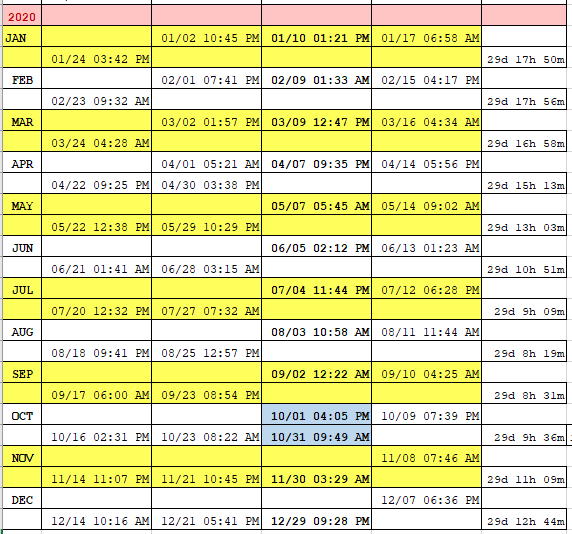Moon Phases Calendar & Moon Info
Moon Phases Calendar (Solid White = Full Moon)
Special Moon Events in 2019: Jan 20 Total Lunar Eclipse visible in New Orleans
Special Moon Events in 2020: Oct 31- Blue Moon
Full Moon Names
January: Wolf Moon
February: Snow Moon
March: Worm Moon
April: Pink Moon
May: Flower Moon
June: Strawberry Moon
July: Buck Moon
August: Sturgeon Moon
September: Corn Moon or Harvest Moon*
October: Hunter's Moon or Harvest Moon*
November: Beaver Moon
December: Cold Moon
September / October: Harvest Moon* - Technically, the Harvest Moon is the Full Moon closest to the September equinox around September 22. Most years it is in September, but around every three years, it is in October. The Harvest Moon is the only Full Moon name which is determined by the equinox rather than a month.
As the Earth travels around the Sun in its orbit, the north-south position of the Sun changes over the course of the year due to the changing orientation of the Earth's tilted rotation axes with respect to the Sun.
The dates of maximum tilt of the Earth's equator correspond to
the summer solstice and
winter solstice,
and the dates of zero tilt to
the vernal equinox and
autumnal equinox.
In the northern hemisphere, the Winter solstice is day of the year (near December 22) when the Sun is farthest south.
The winter solstice marks the first day of the season of winter. The declination of the Sun on the (northern) winter solstice is known as the tropic of capricorn (-23° 27').
declination - The celestial coordinate of an object corresponding to latitude projected on the sky. Declination is measured from -90° (south pole) to +90°(north pole), with 0° corresponding to the celestial equator.
celestial equator - The projection of the Earth's equator onto the sky. The declination coordinate is an angle measured with respect to the celestial equator.
The winter solstice is the shortest day of the year (the length of time elapsed between sunrise and sunset on this day is a minimum for the year).
sidereal period: The period for the Moon to complete a revolution relative to the fixed stars, 27.322 days.
synodic period: The period for the Moon to complete a revolution relative to the Earth-Sun line.
Moon phases occur with a period equal to the synodic period of the moon,
29.530589 days, or 29 days, 12 hours, 44 minutes, 3 seconds.
However, there is a great deal of variation in the actual time for a given lunation (the time between two successive new moons).
Moonrise and moonset times correspond directly to the phase of the moon.
For example, when the Sun, Earth, and Moon are in a line (in that order), the near side of the Moon is facing both the Earth and the Sun, and will therefore be completely illuminated, corresponding to a full moon.
Since a full moon will be overhead at midnight, it will therefore rise around 6 p.m. and set around 6 a.m.
Similarly, if the Sun, Moon, and Earth are in a line (in that order), the illuminated side of the Moon faces the Sun, while the other side faces the Earth, corresponding to a new moon.
Since a new moon will be overhead at noon, it will therefore rise around 6 a.m. and set around 6 p.m.




Comments
Post a Comment